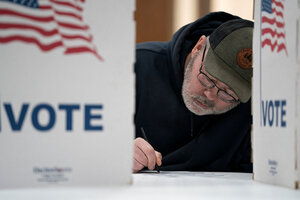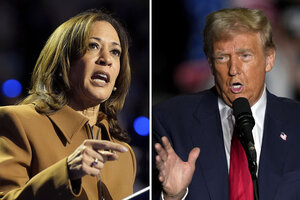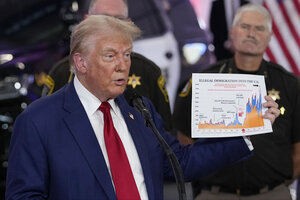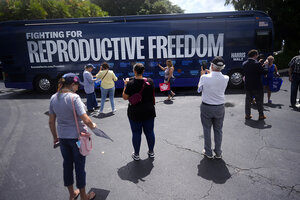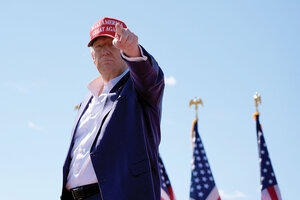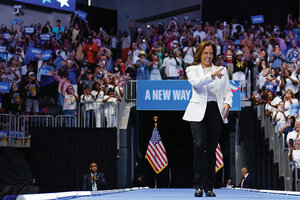Forget 1968. The DNC is underway in Chicago with minimal disruption.
| Chicago
This isn’t 1968.
The Democratic National Convention kicked off in Chicago amid dire predictions of a replay of the party’s ’68 gathering. That’s when riots and police attacks on anti-war protesters outside the convention combined with a messy floor fight inside the hall to derail Democrats’ chances at the White House.
For now, at least, there’s no comparing the two.
Why We Wrote This
After pro-Palestinian encampments disrupted college campuses this spring, many predicted major clashes at the Democratic National Convention – a repeat of 1968’s DNC. But so far, the protests in Chicago have been smaller than expected.
Pro-Palestinian organizers convened their March on the DNC on Monday with great fanfare but fairly small numbers, leading a mostly peaceful protest of a few thousand people that in both scale and impact paled in comparison to the disruptive events of a half-century ago.
Rally speakers and many participants said they saw little difference between President Joe Biden and Vice President Kamala Harris on Gaza. But the size of the crowd suggested that some of those who feel deep sympathy for Gaza residents and fury at Israel aren’t as mad at the vice president. Polls indicate that since Ms. Harris became the nominee, she’s made massive gains over President Biden among core Democratic constituencies that have been most supportive of the Palestinian cause, including young voters and voters of color.
“If it was still Biden, I think there would be a lot more people out here. It’s a very different attitude. I think people are hoping against hope that she’ll do the right thing,” said Brendan M., a protester from Chicago who declined to give his last name.
How Harris is viewed differently from Biden
Organizers had predicted last week that the protest might draw as many as 40,000 people – four times the number of anti-Vietnam War protesters that showed up in Chicago in 1968. But Monday’s turnout, at most a few thousand, was small enough that hundreds of protest signs sat unused in piles.
Vice President Harris hasn’t broken from President Biden on Middle East policy. But she has rhetorically expressed more sympathy for the plight of Palestinians in Gaza currently facing Israeli strikes and famine. More than 40,000 people have been killed in Gaza, according to the Gaza Health Ministry, since Israel began its war in the territory last fall triggered by Hamas’ attack that left more than 1,100 people dead in Israel. More than 85% of people in Gaza have been displaced from their homes.
April Ignacio, a vice chair of the Arizona Democratic Party, is a Harris delegate who joined the protest. She believes that the protest “absolutely” would have been much larger if President Biden were still the Democratic nominee. She personally is “far more excited” about having Ms. Harris at the top of the ticket because of the historic nature of her candidacy. “I’m going to get to vote for a Black female as the president,” she says. “I can’t believe that this is happening in my lifetime. And I’m excited about that.”
Daniel Smith, a protester from Kalamazoo carrying a “Michigan demands not another bomb” sign, says he’d been interviewed by more than a half dozen journalists eager to talk to a swing state protester – a sign of the outsized level of coverage, given the size of the protest. “We were hoping that there’d be more” fellow protesters, his friend Don Cooney says. “Of course.”
Mr. Cooney says he plans to vote for Ms. Harris. Mr. Smith is torn about how he’ll vote this fall. “I find it very hard to vote for somebody who’s enabled genocide, so it’s a difficult choice for me,” he says. But he is more open to backing Vice President Harris than he had been for President Biden, because “she has expressed more empathy for Palestinian suffering.”
Disruptions and a handful of arrests
Faayani Aboma Mijana, a spokesperson for the coalition that put on the event, says that in their view “not a lot has changed” from 1968 to now: “The Democratic Party is still a pro-war party, while claiming to represent working and marginalized people.” They argued the protest was “a strong turnout, given the fact that it’s a Monday and a workday.”
The protests Monday were mostly peaceful, though late that afternoon, a few hundred protesters pushed through the outer security perimeter, leading to a handful of arrests and a temporary shutdown of the security perimeter. That created bottlenecks and long lines for delegates and other attendees as the convention began, leaving the center itself half empty for early speeches. During President Biden’s address Monday night, a small group of protesters held up a banner that read “Stop Arming Israel,” but it drew little attention.
Things could have gone very differently.
For much of the spring and early summer, pro-Palestinian encampments on college campuses led to clashes, arrests, and heavy media coverage – and laid bare a major fissure in the Democratic Party. President Biden’s ongoing support for U.S. military aid to Israel, even as he criticized its disregard for civilian life in its campaign against Hamas, infuriated many on the left. The Democratic National Convention in Chicago, the metro area with the largest Palestinian population in the country, seemed a likely target for massive protests.
But former Chicago Mayor Lori Lightfoot scoffs at the 1968 comparisons.
“This is a different time, place, everything from 1968. The city continues to learn every year,” Ms. Lightfoot says in a brief interview inside the convention. “The police understand that the protesters have First Amendment rights.”
Chicago’s history with protests
Chaotic protests aren’t exactly ancient history in Chicago. Ms. Lightfoot, the first Black woman to serve as Chicago’s mayor, lost her 2023 reelection bid partly because of how she handled the 2020 Black Lives Matter protests and police response. The city has a long history of police violence and tensions between law enforcement and brown and Black communities.
Current Chicago Mayor Brandon Johnson, a former teachers union organizer and avowed progressive, replaced Ms. Lightfoot – then cast the tiebreaking vote to pass a city council resolution calling for a ceasefire in Gaza – a vote that many of the protesters celebrated.
Chicago Police Superintendent Larry Snelling was personally on hand to help coordinate the police response at the DNC. He walked ahead of the march on Monday evening as his officers steered protesters along a preapproved parade route that took them near the edge of the security perimeter around the United Center, the stadium hosting the convention’s evening programming.
There are still three days and nights left to go – and it’s worth noting that in 1968, it wasn’t until a few days into the convention that violence broke out in earnest. And more developments in Gaza could reignite protesters’ fury between now and the election. But so far, nothing has disrupted Democrats’ coronation of Vice President Harris as their nominee.









